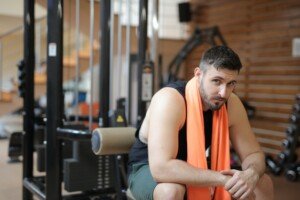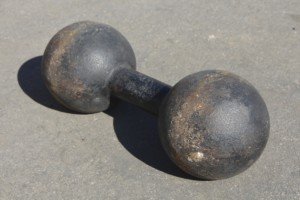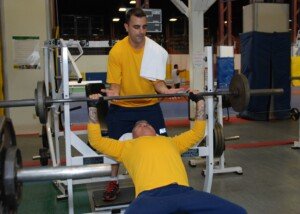
Are you fed up with the vague, non-descript guidelines of weightlifting for thoracic aortic aneurysm?
Finally, here are guidelines that you can make sense out of.
A diagnosis of a thoracic aortic aneurysm doesn’t mean you must give up lifting weights.
There are several problems with the standard guidelines or “restrictions” for people with a thoracic aortic aneurysm, when it comes to lifting weights.
Weightlifting guidelines for those with a thoracic aortic aneurysm attempt to be a one-size-fits-all template.
Vague Guideline #1: People with thoracic aortic aneurysm should not lift more than half their body weight.
The problem here is that obese people (with thoracic aortic aneurysm) who’ve never done strength training get a free pass for lifting a lot of weight, while lightweight but muscular, strong people who’ve been training all along (and then learn they have thoracic aortic aneurysm) get “punished” for being lightweight.

Shutterstock/LightField Studios
According to this guideline, a 280 pound obese man gets to work out with 140 pounds, while a 160 pound highly trained man gets limited to 80 pounds, even though the 160-pound, muscular man may be significantly stronger than the 280-pound fat man!
In fact, the very heavy man may struggle and strain with just 90 pounds, while the smaller man easily hoists half the big guy’s weight: 140 pounds!
Which man, then, will have the greater blood pressure spike and thus strain his aorta more? The 280-pound, weaker man!
“Obviously, these recommendations are guidelines, and cannot be universally applied,” says Allan S. Stewart, MD, a cardiothoracic surgeon at HCA Florida Mercy Hospital in Coconut Grove.
“Fit people would have more ease in lifting heavier weights, but they are also the ones who are more likely to ignore the guidelines.
“Deconditioned people usually won’t lift 50 percent of their body weight, or they wouldn’t be deconditioned!”
Vague Guideline #2: People with thoracic aortic aneurysm should not lift more than 50 pounds.
Gee, does this mean it’s okay, then, for someone with a thoracic aortic aneurysm to lift 40 pounds – over his or her head – 20 times in a row?
A highly trained person with recently diagnosed thoracic aortic aneurysm may find it easy to lift 40 pounds over his head 20 times (no straining at all, and thus, no aortic root strain).
Whereas a deconditioned patient must strain just to push 40 pounds up only once. This guideline is way too ambiguous.
This vague guideline also doesn’t distinguish among different kinds of lifting.
For instance, a leg press of more than 50 pounds (e.g., 80 pounds) is very easy even for deconditioned people. So why should this be prohibited?
Whereas, a dumbbell bent-over row of 45 pounds would require most untrained women to strain – to do even one repetition, yet according to this guideline, it’s acceptable!
Dr. Stewart explains: “Isolated arm work, like dumbbell curls, will impose little strain on the root. The rule of thumb is that if you are stressing your core (things that make you go Hmmm!), it’s straining your root pressure.”
So if dumbbell curls are okay, does this mean it’s safe for women with aortic aneurysm to curl a 45 pound barbell (less-than-50-pound-rule), even if they must strain to get the reps out?
According to the International Registry of Acute Aortic Dissections: Patients often ask exactly how much weight it is permissible to lift.
Unfortunately, it is not possible to provide a blanket answer to that question, as it all depends on the patient’s size, muscular strength, physical fitness, and how the weight is actually lifted.
Rather than try to define a numerical limit, it may be more appropriate and useful to explain that patients can lift whatever weight they can comfortably lift without having to “bear down” or perform the Valsalva maneuver.
So if you can curl a 100-pound barbell without straining, the absence of straining is your clue that this resistance is not dangerous to your aortic root.
In other words, avoid anything that makes you strain, grunt, or want to grunt or moan.
Vague Guideline #3: Very frightening to those newly diagnosed with a thoracic aortic aneurysm who are weightlifters is when they hear, “Don’t lift more than 10 pounds.”

According to this rule, a highly trained individual, strong as a bull, but recently diagnosed with a thoracic aortic aneurysm, is now rendered prohibited from lifting his or her own baby and even a large watermelon!
The 11-pound bowling ball becomes a 9-pounder. Don’t move the ficus plant; don’t place the 15-pound dog in the car or handle a 12-pound suitcase.
Athletes or even sedentary people, newly diagnosed with a thoracic aortic aneurysm, will exclaim, “This can’t be real!”
A rule this strict is given because it virtually guarantees there will be no aortic dissection triggered by heavy lifting, and it’s easier for a cardiologist to be this strict than to open up the floodgates for endless questions that would result from broadening the restriction to 50 pounds or half one’s body weight.
Vague Guideline #4: People with aortic aneurysm should flat-out avoid lifting weights.

This restriction is the easiest for a physician to administer.
It minimizes patient questions about hypothetical scenarios involving weightlifting exercise or lifting weights on the job, and reassures the doctor that the patient was given the safest recommendation possible – should a dissection occur.
Dr. Stewart says, “. . .the variability (in guidelines) results from an ignorance about the contribution of weight bearing to the risk of dissection.”
Dr. Stewart adds that “the only real data comes from studies on athletes with normal aortas, where a pressure catheter was placed in the aorta during lifting.
“It was demonstrated that lifting an excess of 50 percent of one’s body weight puts a supra-physiologic stress on the root.
“It seems fairly obvious, that if the root is already diseased, then a supra-physiologic load would be bad.
“No correlation has ever been found, however, that weightlifting will lead to dissection.
“What does seem intuitive, though, is that subjecting a weak piece of pipe to high pressure, will further increase the weakness of the pipe until it breaks (or in the case of the aorta, dissects).”



























